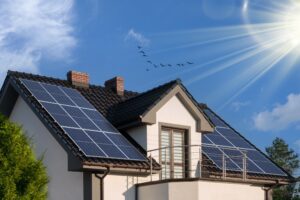Are ground-mounted solar panels a viable option for my home? More often than not, our team of installers at Effective Home will opt for roof-mounted solar PV systems, but where this isn’t possible we might recommend that you ground-mount solar panels at your property instead. Speak with one of our solar experts today for an accurate solar panel quote and expert project advice.
Solar panels are an increasing presence on roofs in our neighbourhoods. The number of rooftop solar panel installations in the UK has risen steadily in recent years among growing concerns over high energy bills and the environmental damage caused by fossil fuels.
In 2023, nearly 190,000 homes and businesses installed roof-based solar panels — the highest number in 12 years. With rooftop solar energy installations on the rise, you may assume that’s the only place solar panels can go – as high as possible off the ground to get the most sunlight.
But that’s not always the case. Solar panels can also be installed on the ground, and in some situations, a ground-mounted system may be a better option or the only practical solution.
This post looks at:
- How solar panels work
- Types of ground-based solar panels
- Pros and cons of ground-mounted systems
- Ground-mounted solar panel costs
- Bifacial solar panels for a ground-mounted solar system
This guide will give you a good idea of whether a ground-mounted solar panel system is right for you and your property.
- Create a Tailored Quote Based On Your Circumstances
- Takes Less Than 2 Minutes
- Fixed-Online Quotes

How Solar Panels Work
Ground-mounted solar panels provide an option for householders who want to generate their own electricity but whose homes aren’t ideal for roof-mounted solar panels. Ground-mounted solar refers to any solar panels installed on the ground, rather than on the usual roof – ground-based systems are often installed in gardens, courtyards, or fields – or, on a larger scale, with commercial properties at solar farms.
Solar panels on the ground work in the same way as solar panels on roofs. They use photovoltaic (PV) technology to turn sunlight into direct current (DC) electricity which is then converted by a solar inverter into an alternating current (AC) that can be used to power homes and electrical appliances.
Ground-mounted solar arrays, just like their roof-mounted counterparts, work best in direct sunlight wherever possible, but they also function in partial shade, although they will produce a lower level of power.
Types of Ground-Mounted Solar Panels
Roof-mounted solar panels are attached to roofs with a system of roof anchors, mounting rails, and clamps. Ground-mounted solar systems are fixed to a frame or pole (when fixed to a pole, these panels are sometimes referred to as pole-mounted solar systems). The panels are elevated from the ground by anything from a few inches to several feet depending on requirements.
Frame-Mounted Solar Panels
Standard, frame-mounted solar panels – also called rack-mounted solar panels – resemble a rooftop solar panel installation. But they’re attached to a metal frame anchored in the ground by concrete for stability.
The frame holds the solar panels at a fixed angle, tilted upwards. The angle of some frame-mounted solar installations can be adjusted manually throughout the year, allowing for optimal sunlight exposure as the position of the sun in the sky varies with the changing seasons.
Rack-mounted solar panels cost less than pole-mounted panels and are easier to maintain than both rooftop solar panels and pole-based installations. However, they’re more expensive than rooftop panels, need more space than a pole-mounted system, and can be less efficient, with fewer optional extras such as solar trackers when you install solar panels of this kind.
Pole-Mounted Solar Panels
Pole-based solar panel systems support multiple panels on a single pole and raise them higher off the ground than a frame-based installation. They take up less space than frame-mounted installations and can be more efficient.
They usually incorporate a solar tracking system that automatically tilts the panels to get the maximum amount of sunshine throughout the day. This can boost energy production of the solar panels by around 25% or more.
Pole-mounted solar panels do cost more than a rack-mounted system and are more difficult to maintain than all other types of solar arrays.
There are two types of pole-mounted solar panel installations:
- A single-axis system generally moves the panels through a north-south orientation so the panels can be angled eastwards as the sun rises and towards the west as the sun sets.
- Dual-axis pole-mounted panels move in an east-west orientation as well as north-south. This optimises output during seasonal movements of the sun. (In our northern hemisphere, the sun appears lower in the sky as we move towards winter).
Advantages of Ground-Mounted Solar Panels
Ground-mounted panels provide an option to go solar if your home isn’t suitable for rooftop panels. They offer greater control over panel angle and direction, getting optimal sunlight to generate more energy.
Because these systems are on the ground, cleaning, maintenance and repair is usually much easier and safer, so you won’t necessarily need a specialist to keep the panels in good condition in order to prolong their lifespan.
With no limitations due to rooftop size, ground-mounted solar energy systems have more design flexibility. If you have sufficient ground space, you can have large solar arrays or the scope for expansion.
Furthermore, solar panels on the ground offer all the benefits of rooftop solar panels:
Payback
Solar panels can save households thousands of pounds. They typically last 25 to 30 years. Within 10 years or sooner, you start to see a return on your investment as money saved on energy bills begins to exceed installation cost.
You can also get paid for excess solar-generated electricity you send back to the national grid under the Smart Export Guarantee Scheme (SEG).
Lower Electricity Bills
Generating your own electricity with solar panels means you use less electricity from the grid. The Energy Saving Trust estimates solar panels cut electricity bills by up to 70%. With solar battery storage, that figure could increase to 90%.
Environmental Benefits
Traditional fuels – coal, oil, and natural gas – pollute the atmosphere and release toxic emissions that drive climate change. Unlike these fossil fuels, solar energy produces clean, renewable electricity, with no greenhouse gases and minimal carbon emissions.
Increased Property Value
Research suggests solar panels can add value to a home and result in a faster sale when placed on the market. According to some estimates, properties with solar panels sell for as much as 20 to 25% more than the same type of homes without them.
- Create a Tailored Quote Based On Your Circumstances
- Takes Less Than 2 Minutes
- Fixed-Online Quotes

Drawbacks of Ground-Mounted Solar Panels
Although ground-mounted solar panels have several advantages, they also come with some drawbacks compared with rooftop systems. Rooftop solar panels don’t take up usable space while ground-mounted installations occupy land that could be used for other purposes.
That land usually needs to be fairly sizeable. Many properties don’t have the open, unshaded space required for ground-mounted solar panels, especially frame-mounted systems, or owners might be forced to make a decision to give up more of their garden space to accommodate the solar array.
If solar panels are on land that’s easily accessible, they could be targeted by vandals or thieves, so that’s a real concern for some.
A further disadvantage of a ground-mounted solar array is the infrastructure required, which increases installation costs.
Planning Regulations
You’ll almost certainly need planning permission to install a ground-based solar energy system. Planning consent is necessary for solar panels on the ground if the system is larger than four or five panels. A typical three-bedroom house needs twice as many solar panels as that.
Why Ground-Mounted Solar Panels Cost More than Rooftop Solar Panels
A typical rooftop solar panel system costs £7,000-plus for a three-bedroom home. You can expect to pay more for a ground-mounted solar array because it needs more materials and installation takes longer.
Unlike rooftop panels, solar panels on the ground have no supporting structure already in place. The system has to be built from scratch and anchored into the ground for stability.
A ground-based solar panel system also typically needs more wiring because it’s farther from the home’s electrical system. And the cables usually need to run along trenches to avoid damage.
Some estimates put the cost of ground-based solar panels at 25 to 35% more than rooftop solar panels.
Ground-Mounted Bifacial Solar Panels
The unique design of bifacial solar panels makes them an ideal choice for a ground-based solar energy system.
Regular, monofacial solar panels capture sunlight with front-facing solar cells. Bifacial solar panels absorb energy from the sun on both sides of the panel. This can potentially boost energy output by almost one-third.
Ground-mounted bifacial solar panels generate power from diffused or reflected sunlight on the back and direct sunlight on the front. They cost more to install than monofacial panels because they’re heavier and less flexible, but do generate up to 30% more electricity than single-sided solar panels.
The power output of ground-mounted bifacial panels varies according to the surrounding environment and the light-reflective properties of the surface where the system is installed.
Double-sided solar panels are typically found in commercial applications but in some cases can be used to power homes. They can, for instance, be incorporated into the design of residential exterior structures such as a pergola or a carport. The high energy efficiency of bifacial panels means they typically need less space to meet domestic energy requirements.
Are Ground-Mounted Solar Panels Suitable for Your Property?
Rooftop solar panels are the most common choice for homeowners, but some properties aren’t ideal for solar panels on the roof. Perhaps you don’t have a pitched roof, for example, or your roof is too small. Or maybe you live in a thatched cottage or a property shaded by adjacent buildings.
In these situations, ground-mounted solar panels can generate free electricity for your home if it has enough land around it and ensure that you don’t miss out on the opportunities afforded by home solar power generation.
- Create a Tailored Quote Based On Your Circumstances
- Takes Less Than 2 Minutes
- Fixed-Online Quotes




